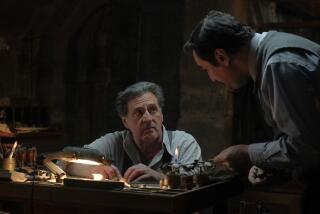‘Dr. Strangelove’ at 50
“It remains as outrageously prankish, juvenile, and derisive as ever,” writes David Denby in the New Yorker magazine’s blog. He’s referring to a true monument of 1960s nuclear-paranoid culture, Stanley Kubrick’s “Dr. Strangelove.”
Denby is a bit late with his 50-year anniversary reappraisal -- the film’s premiere took place in January 1964 -- but his peg is the current screening of a freshly cleaned-up 35-mm print at Manhattan’s Film Forum revival house, so that’s all right. His post is accompanied by a couple of fascinating articles by Eric Schlosser about the relationship between the film and the real-life politics of the nuclear-age Cold War, which the magazine published back in January.
As Denby reports, “Dr. Strangelove” marked the end of Kubrick’s young whippersnapper period, which also gave us “Lolita” (1962), “Paths of Glory” (1957) and “The Killing” (1956). This was followed by what Denby calls the director’s “visionary” stage, beginning with “2001: A Space Odyssey”; the juvenile humor is still present, somewhat, in the later films, but ever more subsumed beneath earnest messaging. This later work proclaims its capital-I Importance, but is uneven; I adored “2001” and still do, but “A Clockwork Orange” has simply withered with age and “The Shining” is and always was dully unwatchable.
The old corrosive Kubrick wit resurfaced in the first half of “Full Metal Jacket,” which made a star of former real-life Marine Gunnery Sgt. R. Lee Ermey, but it was almost canceled out by the second half. Don’t even talk to me about “Eyes Wide Shut.”
Fans who saw “Strangelove” upon its original release may still remember the shock of witnessing the deadly lethalities of nuclear war policy undone by sheer ridicule. It really was the only way to get the point across. Much later, the sinister nonchalance of nuclear policymakers was reported by my former colleague Bob Scheer, in his astonishing 1983 book “With Enough Shovels.” Scheer quoted a Pentagon expert figuring that the U.S. population could survive a nuclear war by digging itself underground until the hostilities passed. “If there are enough shovels to go around, everybody’s going to make it,” he said. “It’s the dirt that does it.” By then it wasn’t funny anymore, just horrifying.
Schlosser points out that, despite the demurrers of Pentagon officials at the time, “Dr. Strangelove’s” basic scenario, a series of mishaps that sends a U.S. bomber on an unauthorized nuclear attack on Russia, was theoretically possible. “In retrospect,” he writes, “Kubrick’s black comedy provided a far more accurate description of the dangers inherent in nuclear command-and-control systems than the ones that the American people got from the White House, the Pentagon, and the mainstream media.”
The schoolboy jokiness of the “Dr. Strangelove” script, with names like “Gen. Jack D. Ripper,” and Col. “Bat” Guano’s response to the order to shoot up a soda machine for a handful of change to make a pay call -- “You’ll have to answer to the Coca-Cola Co.” -- is traditionally ascribed to Kubrick’s co-writer, Terry Southern.
For some reason, however, Denby skips over what is surely the greatest movie line of all time: “Gentlemen, you can’t fight in here! This is the War Room!” He fails to mention some other great moments -- George C. Scott’s performance as Gen. Buck Turgidson is an endless stream of hilarious double-takes -- and one great hidden delight: In the very last scene, if you watch closely, you can see the British actor Peter Bull, playing the Soviet ambassador, cracking up at Peter Sellers’ battle, as Dr. Strangelove, with his own crippled arm.
A remark by bomber captain Maj. “King” Kong about the pep pills, lipsticks and prophylactics in the crew’s survival kit -- “Shoot, a fella could have a pretty good weekend in Vegas with all that stuff” -- originally mentioned Dallas, but was changed to avoid echoes of a certain violent incident that occurred in that city on Nov. 22, 1963. The film’s viewers can still detect the original line on the lips of actor Slim Pickens.
Denby reminds us that many film critics of the day didn’t know what to make of the movie. And not just middlebrows like Bosley Crowther of the New York Times, who fretted about its “contempt for our whole defense establishment.” Pauline Kael sniffed that “artists’ warnings about war and the dangers of total annihilation never tell us how we are supposed to regain control.” (She was not a fan of Kubrick.) Perhaps that’s a sign of how true “Dr. Strangelove” was: It went clear over the heads of people hired to tell us how to think.







